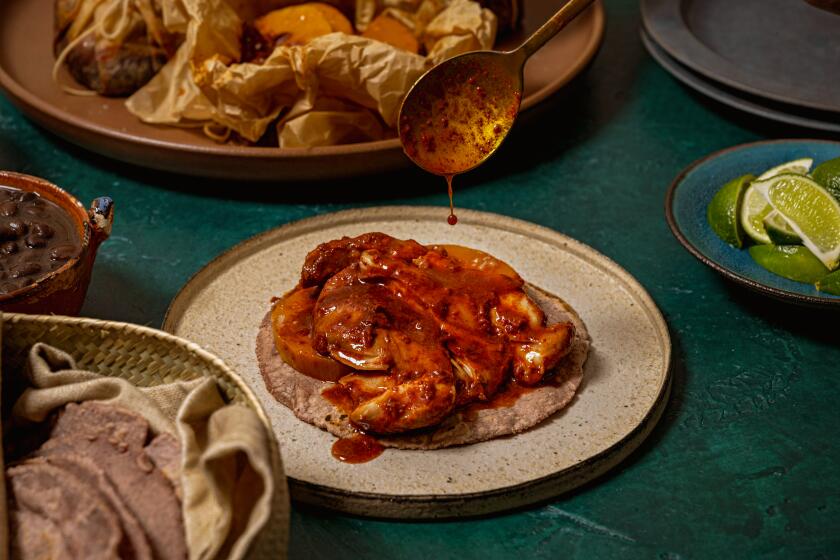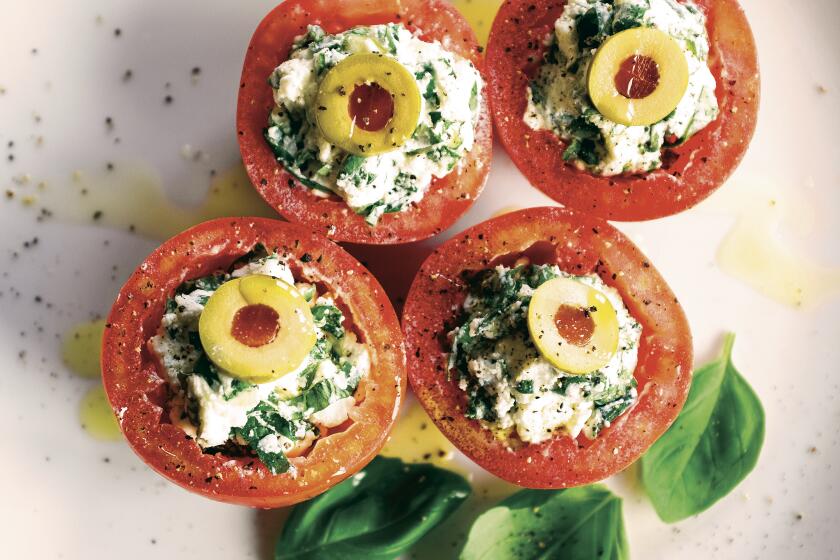Diep Tran's Creamy White Beans in Lemongrass Coconut Broth

- Share via
Cooking white beans in coconut milk transforms this one-pot dish from a potential support act to the main attraction on the table. This vegetarian dish actually takes its cue from one of my favorite Saigon street snacks of sea snails sauteed in a mixture of lemongrass, garlic and coconut milk, though to create depth and lift the earthiness of the beans, I turn to the Malay technique of rempah making, where the tangy and herbaceous lemongrass is blended with makrut lime leaves, galangal and other aromatics, then stir-fried into a fragrant paste. The beans are cooked in the paste, absorbing its flavors. This is excellent served with some white rice, but you also can turn the beans into a dip by cooking it further to condense the broth and serving it with rice crackers or tortilla chips for scooping.
The key to the fragrant broth for this vegan version of a beloved Saigon street snack — using white beans instead of snails — is in the spice paste.
White Beans in Lemongrass Coconut Broth
To make the rempah, prepare the lemongrass; only the tenderest part of the lemongrass will be used. Trim and discard 1 inch of the tough root ends of the lemongrass. Remove the tough outer leaves. Measuring from the cut end, thinly slice 2 inches up the length of the lemongrass. The slices should reveal purple-pink concentric circles. Three lemongrass stalks should produce about ½ cup of sliced lemongrass. Transfer the sliced lemongrass to a blender.
Prepare the galangal: Again, only the tenderest part of the galangal will be used. Trim away any discolored skin and tough nodules from the galangal. Slice the galangal into thin slices, the thinner the better. A ½-ounce piece of galangal should produce about 1½ tablespoons of sliced galangal. Add the sliced galangal to the blender.
Add the turmeric, garlic, shallots, chiles, 2 tablespoons oil and 2 tablespoons water to the blender and blend on high until a fine paste forms, 2 to 3 minutes.
Cook the beans. Add 3 tablespoons of oil to a medium pot over high heat. When the oil starts to ripple, add the rempah paste. It should bubble immediately. Fry the paste on high heat for 2 minutes, scraping the bottom of the pot to prevent the paste from burning. After 2 minutes, lower the flame to medium and continue cooking for another 15 minutes, stirring constantly to prevent burning. The goal is to bring out the umami of the garlic and shallots without burning the natural sugars in them. The paste is done when it takes on a jammy consistency and separates from the oil.
Add the soaked beans, salt and 2 cups of water. Increase the heat to high, bring the pot to a boil, then lower to a simmer. Partially cover the pot with a lid (you can use a ladle or large wood spoon to prop the lid slightly open). Cook until the beans are tender, 1 to 3 hours.
Once the beans are tender, stir in the palm sugar, coconut milk and makrut lime leaves and increase the heat to high. Once it comes to a boil, reduce the heat to low and simmer for a final 10 minutes. Taste and add a little more salt if you’d like.
Garnish with sliced red onions and rau ram and serve with rice.
If you’re short on time, you can substitute the dried beans with 5 cups of cooked canned beans and simmer the beans in the broth for just 15 minutes. The end result won’t be as luscious as cooking the beans from scratch but still will be delicious.
Get our Cooking newsletter
Get a taste of Los Angeles — and the world — with recipes and kitchen tricks from the L.A. Times’ Cooking newsletter.
You may occasionally receive promotional content from the Los Angeles Times.
















